ANAPHY 1 Chapter 2: Integumentary System
1/75
Earn XP
Description and Tags
Chapter 5 sa book uwu
Name | Mastery | Learn | Test | Matching | Spaced |
|---|
No study sessions yet.
76 Terms
What are the main components of the integumentary system?
The integumentary system consists of the skin, hair, glands, and nails.
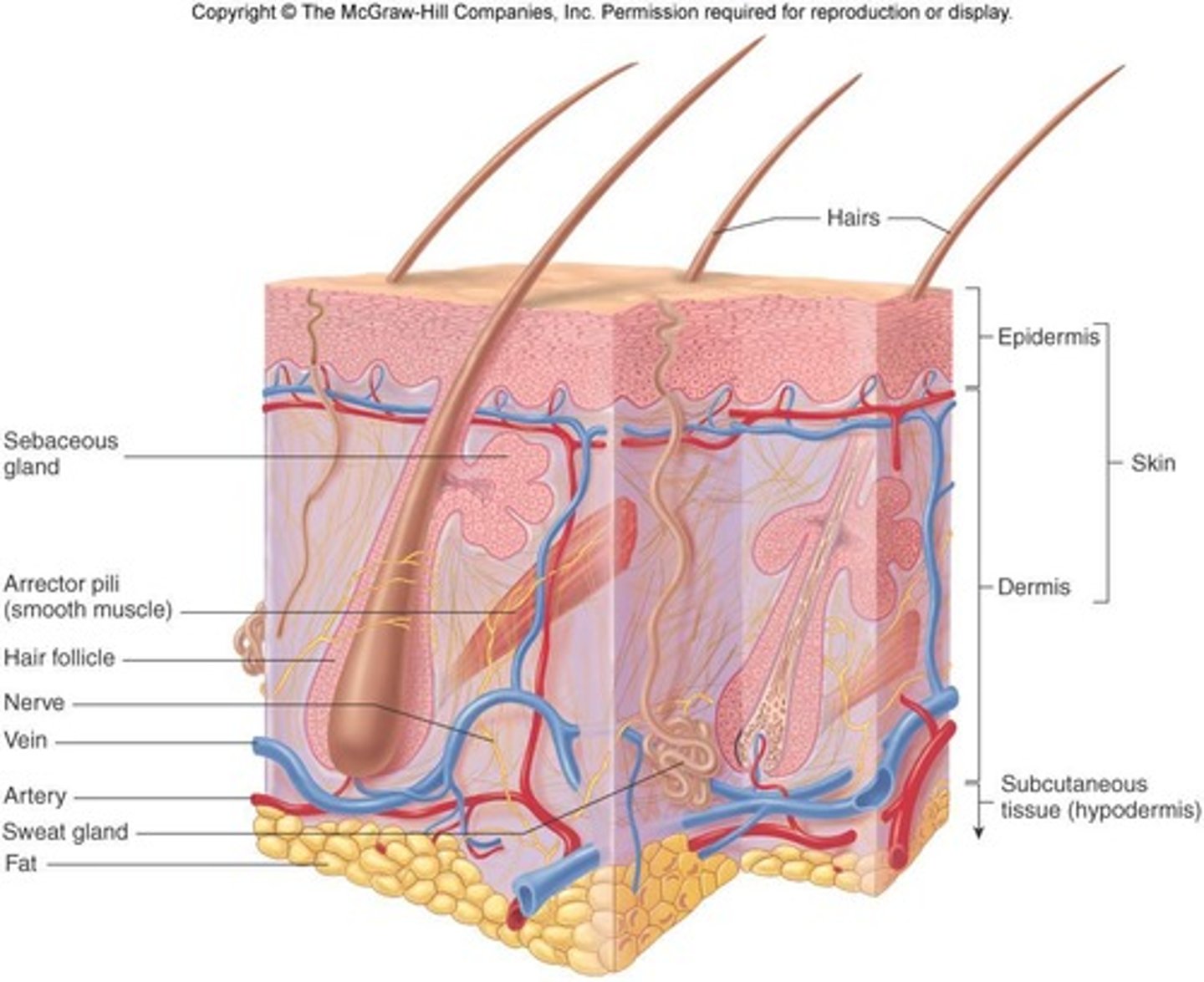
List the five main functions of the integumentary system.
1. Protection against abrasion and UV light, prevents entry of microorganisms, and prevents dehydration. 2. Sensation through sensory receptors for heat, cold, touch, pressure, and pain. 3. Temperature regulation by controlling blood flow and sweat gland activity. 4. Vitamin D production. 5. Excretion of small amounts of waste products.
What is the average surface area and weight of human skin?
The skin has a surface area of 1.2-2.2 m² and weighs 4-5 kg (9-11 lbs).
What are the three major regions of the skin?
The three major regions of the skin are the epidermis (outermost), dermis (middle), and subcutaneous tissue (hypodermis, deepest region).
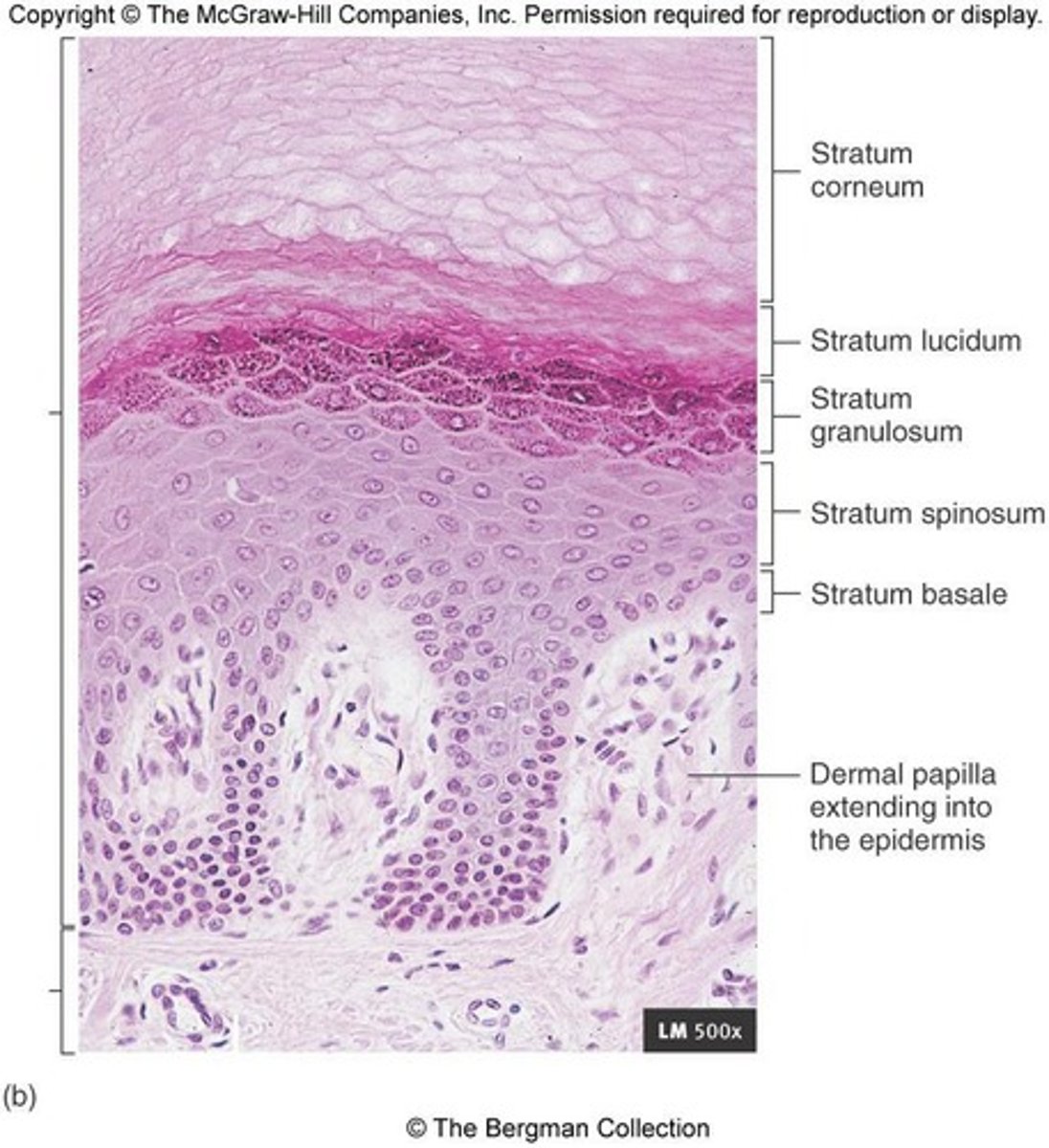
What is the primary function of the epidermis?
The epidermis functions in protection and resists abrasion while reducing water loss.
What type of epithelium composes the epidermis?
The epidermis is composed of keratinized stratified squamous epithelium.
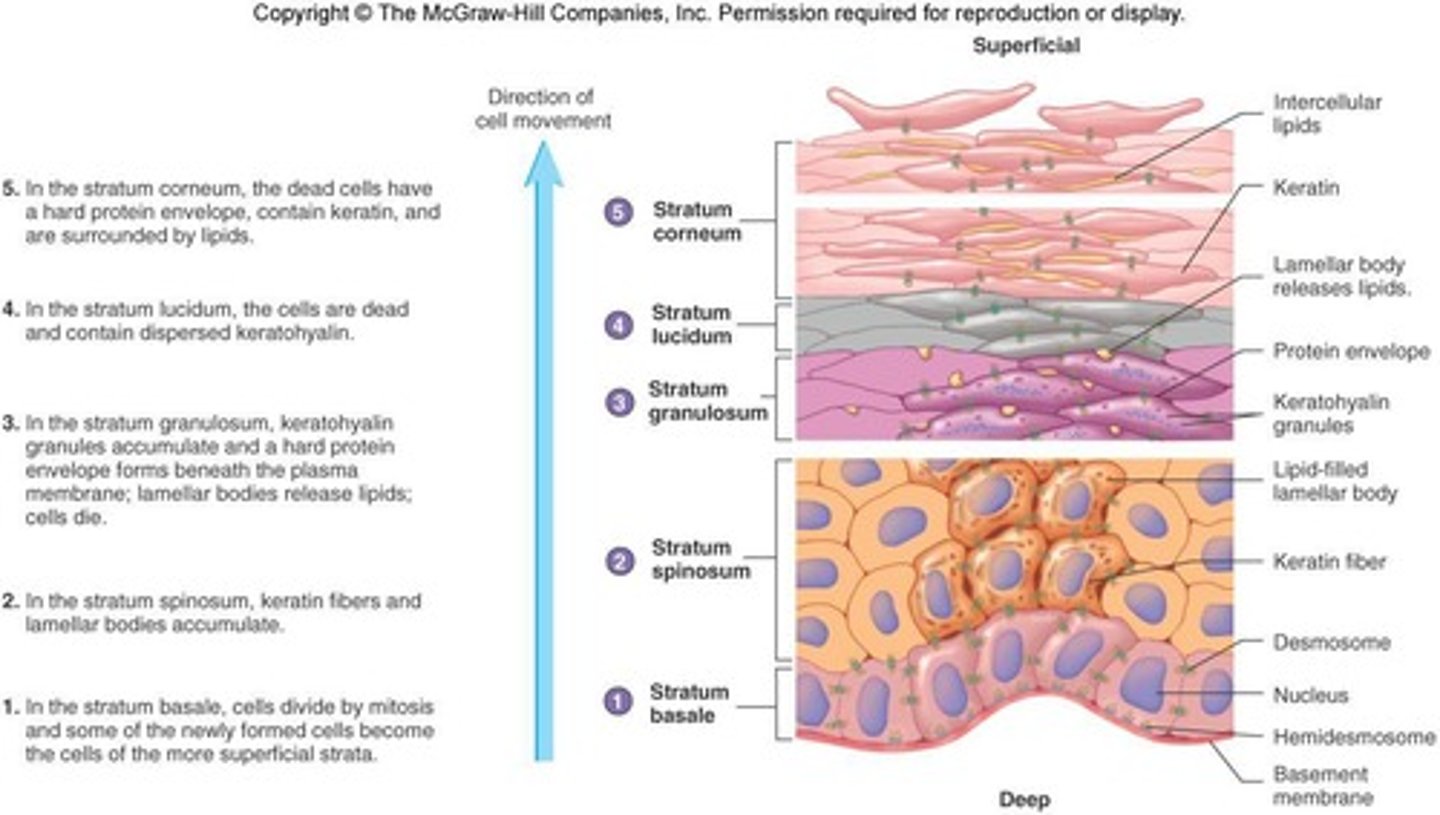
Name the four distinct cell types found in the epidermis.
The four distinct cell types in the epidermis are keratinocytes, melanocytes, Merkel cells, and Langerhans' cells.
What is the role of keratinocytes in the skin?
Keratinocytes are the most abundant cell type in the epidermis and produce the fibrous protein keratin, which gives the skin its protective properties.
What pigment do melanocytes produce, and where are they located?
Melanocytes produce the brown pigment melanin and are found in the deepest layers of the epidermis.
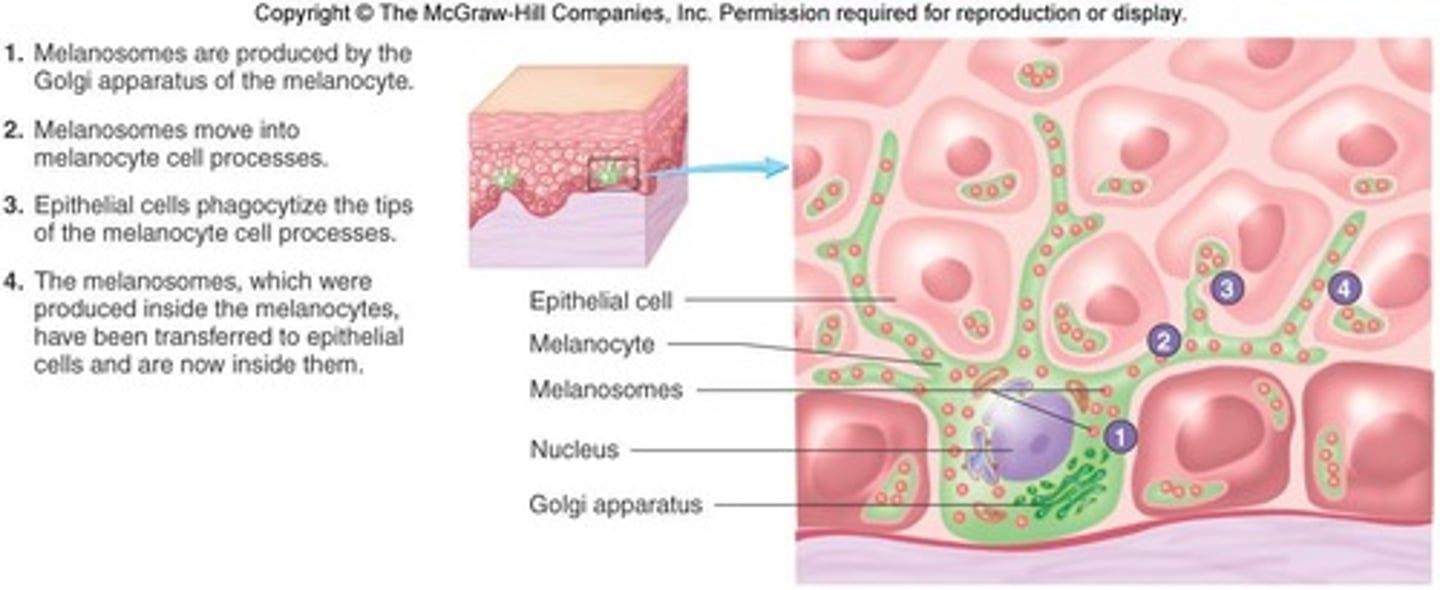
What is the function of Langerhans' cells?
Langerhans' cells are epidermal macrophages that help activate the immune system.
What are Merkel cells associated with?
Merkel cells are touch receptors in association with sensory nerve endings.
Describe the Stratum Basale layer of the epidermis.
The Stratum Basale is the deepest epidermal layer, firmly attached to the dermis, consisting of a single row of the youngest keratinocytes, with structural strength provided by desmosomes and hemidesmosomes.
How often do cells in the Stratum Basale undergo mitotic divisions?
Cells in the Stratum Basale undergo mitotic divisions approximately every 19 days.
What is the significance of the Stratum Spinosum layer?
The Stratum Spinosum contains abundant melanin granules and Langerhans' cells; melanin is taken up by keratinocytes to protect the nucleus from UV damage.
What occurs in the Stratum Granulosum layer?
In the Stratum Granulosum, drastic changes in keratinocyte appearance occur, with keratohyaline and lamellated bodies accumulating, leading to cell death above this layer due to distance from the dermis.
What characterizes the Stratum Lucidum layer?
The Stratum Lucidum is a thin, transparent band superficial to the Stratum Granulosum, consisting of a few rows of flat, dead keratinocytes, and is present only in thick skin.
What is the function of the Stratum Corneum?
The Stratum Corneum is the outermost layer of keratinized cells, accounting for three quarters of the epidermal thickness, providing waterproofing, protection from abrasion and penetration, and rendering the body relatively insensitive to biological, chemical, and physical assaults.
How thick is the Stratum Corneum and how often is it renewed?
The Stratum Corneum is 20-30 cell layers thick, all dead, and millions rub off every day, with total renewal occurring every 25-45 days.
What are the two types of skin based on thickness?
Thick skin and thin skin.
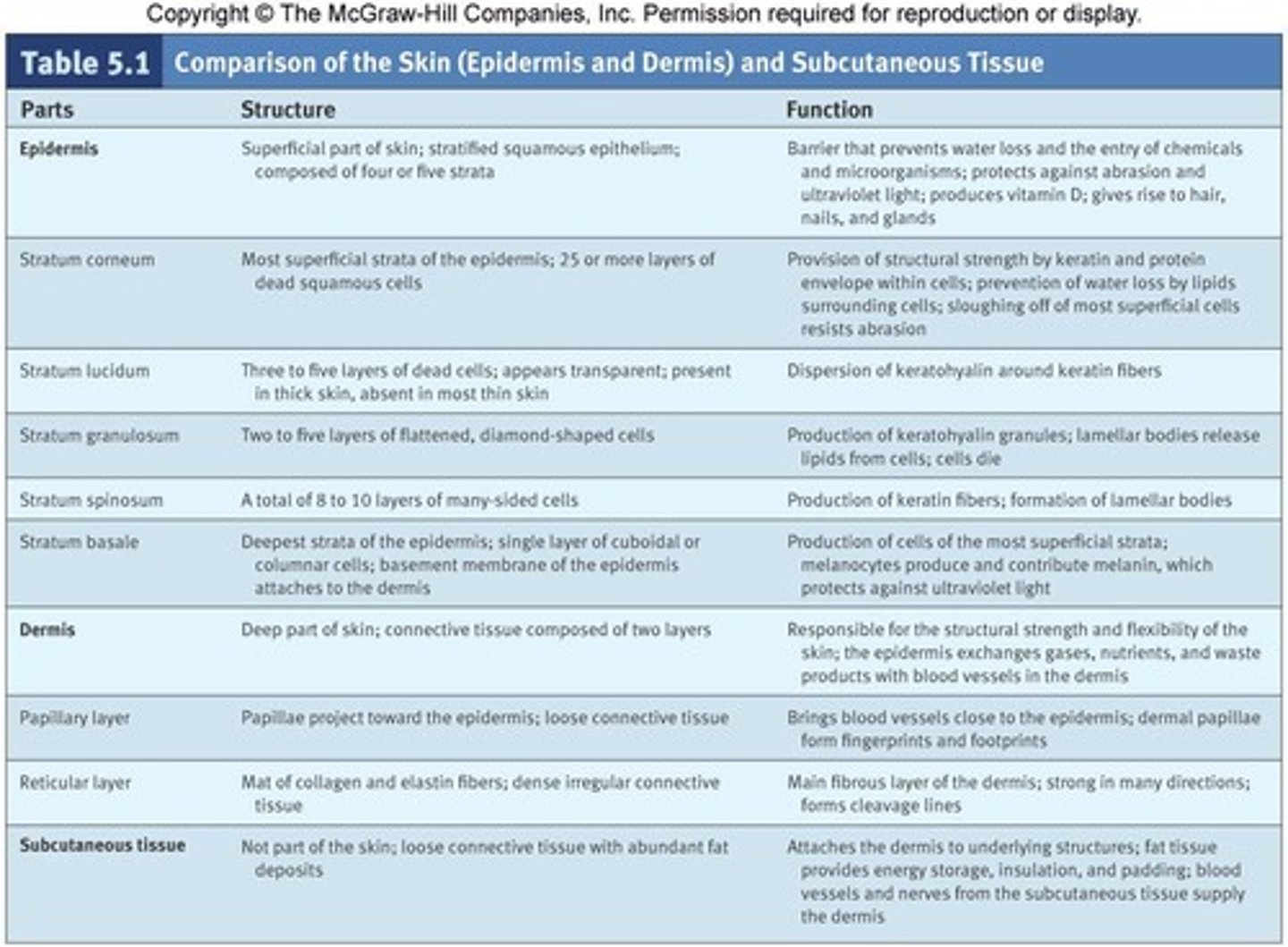
What distinguishes thick skin from thin skin?
Thick skin has all five epithelial strata, while thin skin has fewer cell layers and usually lacks the stratum lucidum.
Where is hair found in relation to thick and thin skin?
Hair is found only in thin skin.
What do melanocytes produce, and how does it affect skin color?
Melanocytes produce melanin, which is transferred to keratinocytes; the size and distribution of melanosomes determine skin color.
What factors influence melanin production?
Melanin production is genetically determined but can be influenced by UV light and hormones.
What causes erythema and cyanosis in the skin?
Increased blood flow causes erythema (red skin), while decreased blood flow and oxygen content result in cyanosis (bluish color).
What pigment can cause a yellowish appearance in the skin?
Carotene, an ingested plant pigment.
What is the dermis and what types of tissue does it contain?
The dermis is the second major skin region containing strong, flexible connective tissue.
What are the two layers of the dermis?
The two layers of the dermis are the papillary layer and the reticular layer.
What is the composition and function of the papillary layer?
The papillary layer consists of areolar connective tissue with collagen and elastic fibers; it contains dermal papillae that supply nutrients to the epidermis and aid in temperature regulation.
What is the significance of dermal papillae?
Dermal papillae are genetically determined and responsible for fingerprints and footprints.
What characterizes the reticular layer of the dermis?
The reticular layer is made of dense irregular connective tissue, accounts for about 80% of skin thickness, and contains collagen and elastin fibers for strength and elasticity.
What causes stretch marks (striae) in the skin?
Stretch marks occur when the skin is overstretched, causing the dermis to rupture.
What is the subcutaneous tissue and its primary components?
The subcutaneous tissue is deep to the skin, composed mainly of adipose and areolar connective tissue, and serves as a shock absorber and insulator.
What is lanugo and how does it relate to hair development?
Lanugo is fetal hair that is replaced by terminal hairs and vellus hairs near birth.
What happens to vellus hairs at puberty?
At puberty, vellus hairs can be replaced with terminal hairs.
What are the main components of a hair?
A hair consists of a shaft above the skin, a root below the skin, and a hair bulb where hair formation occurs.
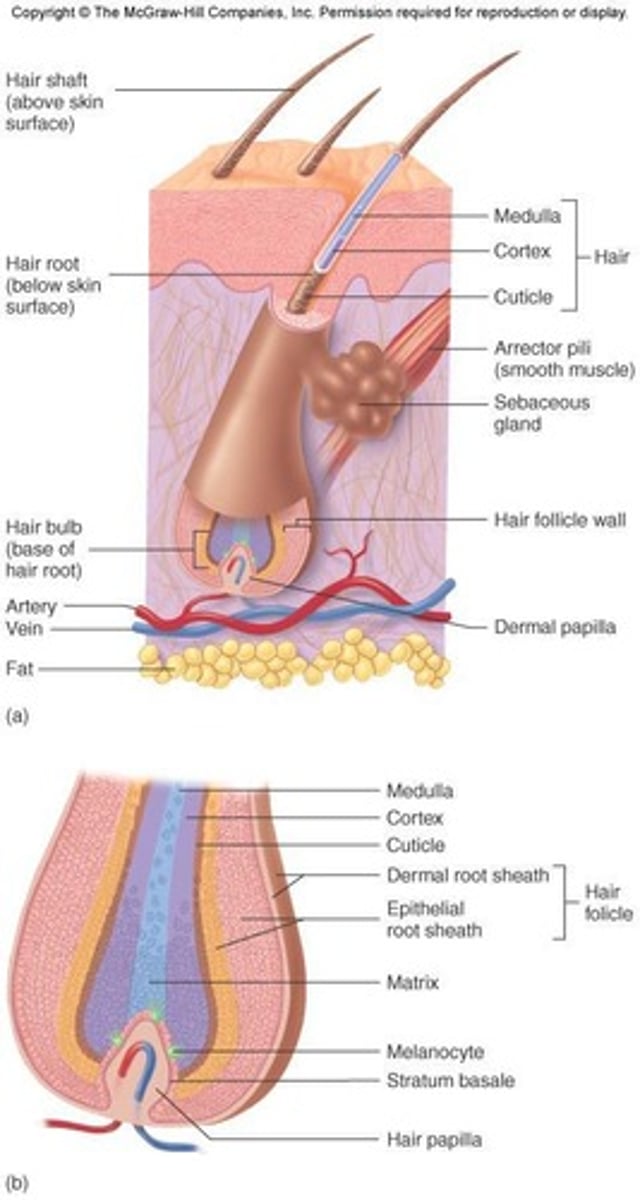
What causes hair to stand on end?
Contraction of the arrector pili muscles causes hair to stand on end, producing 'goose flesh'.
What are sebaceous glands and their primary function?
Sebaceous glands are simple or compound alveolar glands that secrete sebum to soften the skin.
What condition is associated with inflammation of sebaceous glands?
Acne is associated with active inflammation of the sebaceous glands.
What are the two types of sweat glands and their functions?
Merocrine sweat glands produce sweat to cool the body, while apocrine sweat glands are found in axillary and genital areas and empty into hair follicles.
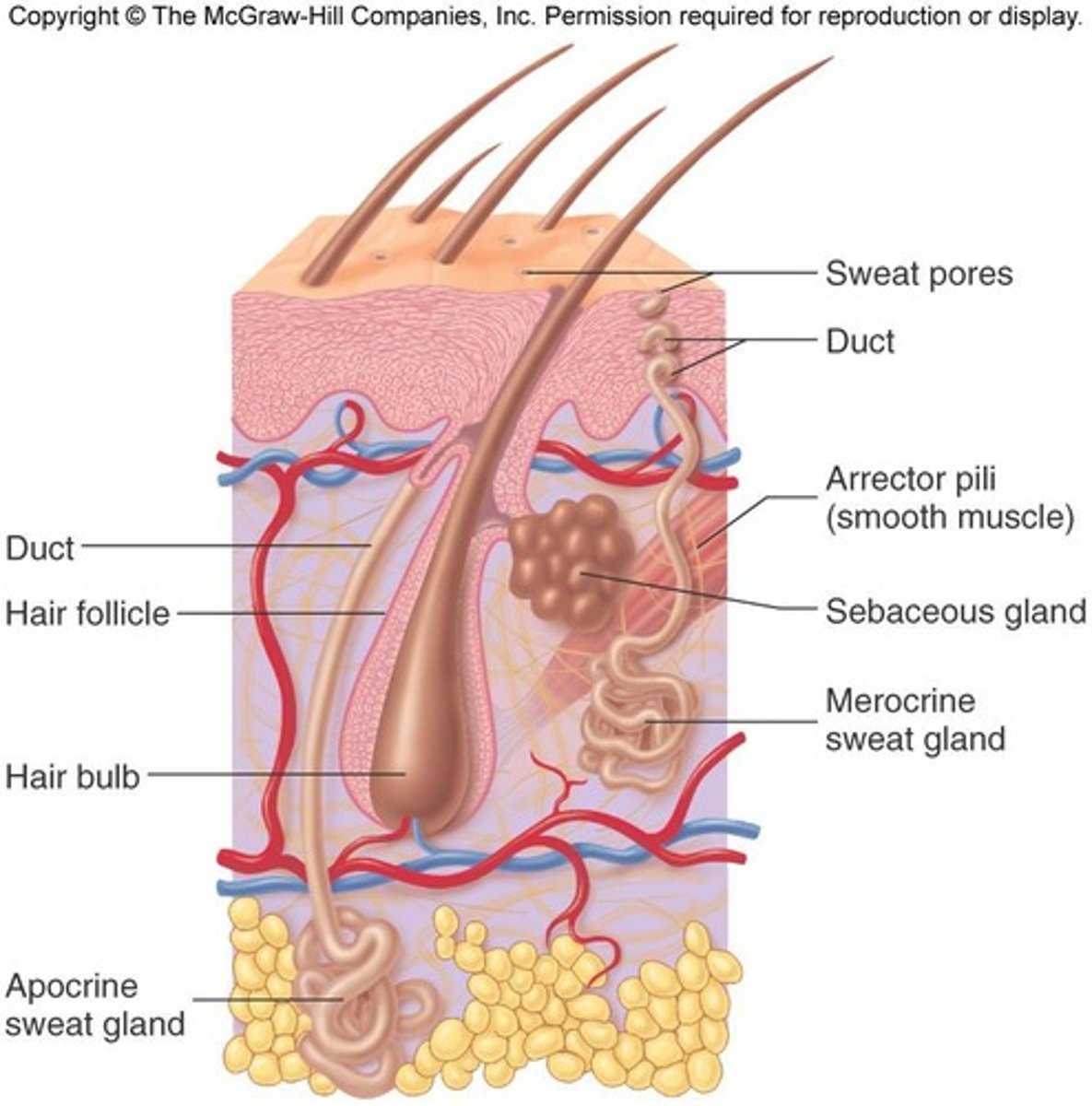
How many sweat glands can a person have?
Up to 3 million sweat glands per person.
What type of glands produce secretions that can cause body odor?
Apocrine glands produce organic secretions that can be broken down by bacteria to cause body odor.
What are ceruminous glands and where are they located?
Ceruminous glands are modified merocrine glands located in the external ear canal that secrete cerumen (ear wax).
What type of glands are mammary glands and what do they secrete?
Mammary glands are specialized sweat glands that secrete milk.
What is the composition of nails?
Nails are composed of Stratum Corneum containing hard keratin.

What is the nail root covered by?
The nail root is covered by skin.
What is the visible part of the nail called?
The visible part of the nail is called the nail body.
What contributes to the formation of the nail?
Nearly all of the nail is formed by the nail matrix, but the nail bed also contributes.
What is the lunula in relation to the nail?
The lunula is the part of the nail matrix that is visible through the nail body.
What are the primary functions of the integumentary system?
The primary functions include protection, sensation, temperature regulation, vitamin D production, and excretion.
How does skin protect against environmental factors?
Skin protects against abrasion and UV light, prevents the entry of microorganisms, and helps regulate body temperature.
What sensory receptors does the skin contain?
The skin contains sensory receptors for heat, cold, touch, pressure, and pain.
What role does vitamin D play in the body?
Vitamin D increases calcium uptake in the intestines.
How does the skin regulate body temperature?
The skin regulates body temperature by dilation and constriction of blood vessels.
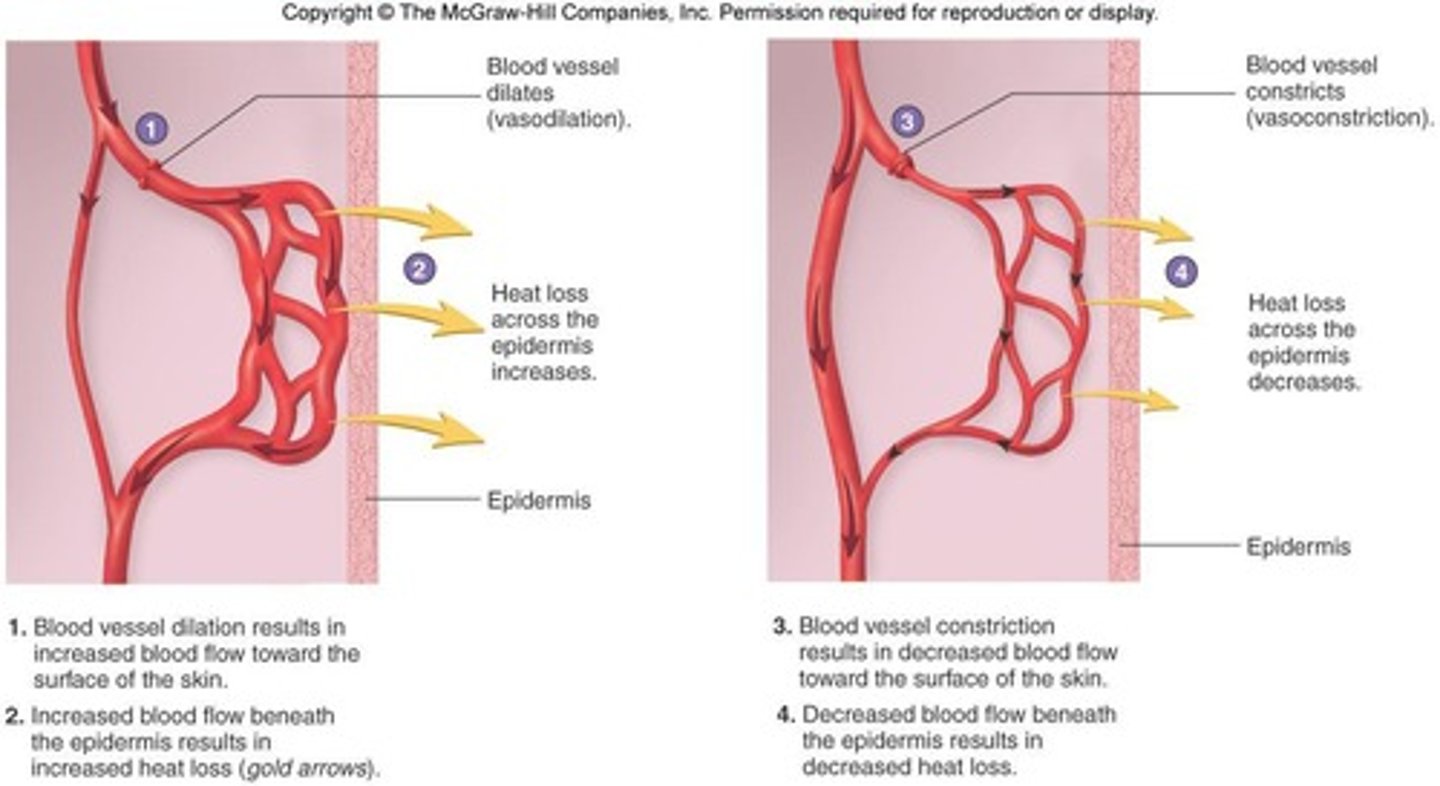
What is the role of sweat glands in temperature regulation?
Sweat glands produce sweat, which evaporates and lowers body temperature.
What is the significance of skin glands in excretion?
Skin glands remove small amounts of waste products but are not important in excretion.
What is the least malignant and most common type of skin cancer?
Basal Cell Carcinoma.
What type of cells proliferate in Basal Cell Carcinoma?
Stratum Basale cells.
What is the typical treatment success rate for Basal Cell Carcinoma through surgical excision?
99% of cases can be cured.
From which skin layer does Squamous Cell Carcinoma arise?
Keratinocytes of the Stratum Spinosum.
Where does Squamous Cell Carcinoma most commonly occur?
On the scalp, ears, and lower lip.
What is the growth rate and metastasis potential of Squamous Cell Carcinoma if not treated?
It grows rapidly and can metastasize.
What is the prognosis for Squamous Cell Carcinoma if treated?
Good if treated by radiation therapy or surgically removed.
Why is Melanoma considered the most dangerous type of skin cancer?
It is likely to metastasize and is resistant to chemotherapy.
What does the 'A' in the ABCD rule for Melanoma stand for?
Asymmetry; the two sides of the pigmented area do not match.
What does the 'B' in the ABCD rule for Melanoma indicate?
Border is irregular and exhibits indentations.
What colors can the pigmented area of Melanoma exhibit according to the ABCD rule?
Black, brown, tan, and sometimes red or blue.
What is the significance of the 'D' in the ABCD rule for Melanoma?
Diameter is larger than 6 mm, the size of a pencil eraser.
How is Melanoma typically treated?
Wide surgical excision accompanied by immunotherapy.
What is the chance of survival for Melanoma if the lesion is over 4 mm thick?
The chance of survival is poor.
What characterizes a first-degree burn?
Only the epidermis is damaged, with symptoms of localized redness, swelling, and pain.
What distinguishes a second-degree burn from a first-degree burn?
It damages the epidermis and upper regions of the dermis, with blisters appearing.
What are the characteristics of a third-degree burn?
It damages the entire thickness of the skin, appearing gray-white, cherry red, or black, with no initial edema or pain.
What is the Rule of Nines used for?
To estimate the severity of burns by dividing the body into areas that are approximately 9% of the total body area.
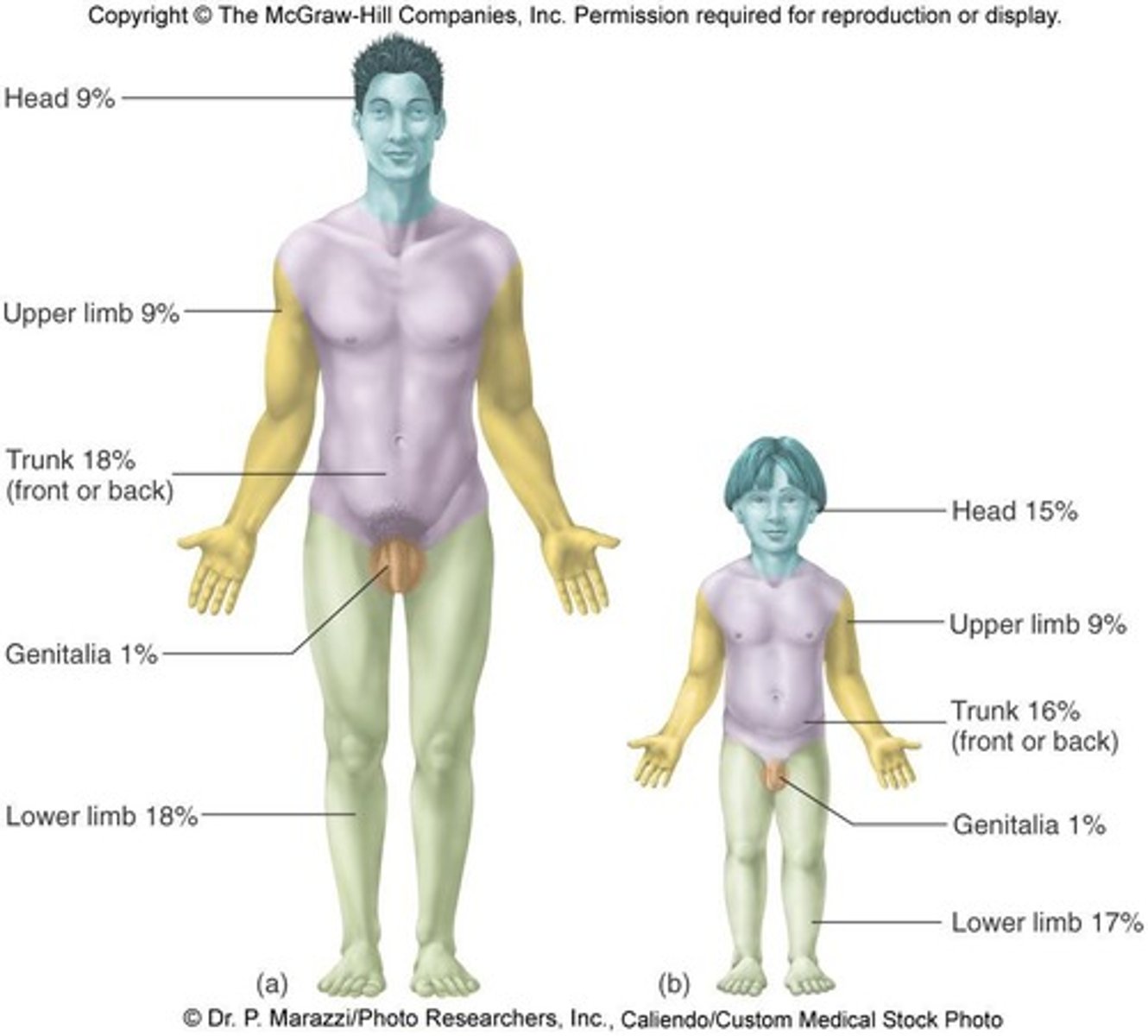
What constitutes a critical burn in terms of body area affected?
Over 25% of the body has second-degree burns, over 10% has third-degree burns, or there are third-degree burns on the face, hands, or feet.
What happens to the skin as a result of aging?
Epidermal replacement slows, skin becomes thinner, loses elasticity, and subcutaneous tissue diminishes.
What are some effects of aging on the integumentary system?
Skin becomes dry and itchy, sweat and sebaceous glands are less active, and the number of melanocytes decreases.